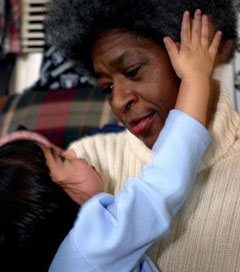In the 150-year history of workers in the San Francisco Bay Area, the watershed event was one that happened 70 years ago – the San Francisco general strike. That year, sailors, longshoremen, and other maritime workers shut down all the ports on the West Coast, trying to form a union and end favoritism, low wages and grueling 10- and 12-hour days. Ship owners deployed tanks and guns on the waterfront and tried to break the strike.
At the peak of this bitter labor war, police fired into crowds of strikers, killing two union activists. Then workers shut down the entire city in a general strike, and for four days, nothing moved in San Francisco. The strike gave workers a sense of power described in a verse in the union song “Solidarity Forever“: “Without our brain and muscle, not a single wheel can turn.”
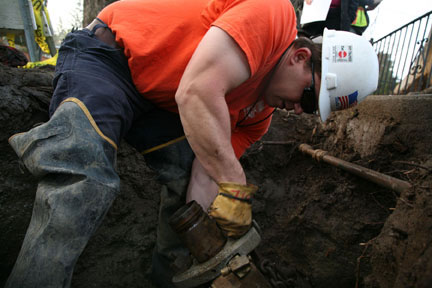
Sam Johnson, a worker for the City of Burlingame, prepares to tap a water main to provide water service to a home. (Photo: David Bacon)
The strike marked the end of a period in which, for 70 years, the efforts of workers to form unions were met with violence and firings. By the end of the 1930s, the International Longshore and Warehouse Union (ILWU) was one of the strongest in the nation; workers had a hiring hall instead of a humiliating shapeup in which they had to beg for jobs, and workers on both sides of the bay were busy building other unions, as well as political organizations that eventually elected mayors and sent pro-worker candidates to Congress. The strike marked the beginning of our modern labor movement.

Linh Vu is a school cafeteria worker at the Toby Johnson Middle School and member of the American Federation of State, County and Municipal Employees. (Photo: David Bacon)
One product of the rising power of unions was the development of the workers' compensation system to ensure that injured and sick workers would receive enough compensation from employers to survive.
While California had passed its first workers' compensation law, the Compensation Act, in 1911, participation by employers was at first voluntary and only became compulsory two years later. Establishment of the system was both a reaction to the high level of workplace injuries at the turn of the century and a product of the progressive movement that sought to limit the power of large corporations. The state established its own compensation fund in 1914 to offer a system with costs lowered by removing insurance corporations and their profits. At the height of the Depression, 18 private insurance corporations went bankrupt, while the state fund continued to pay injured workers.
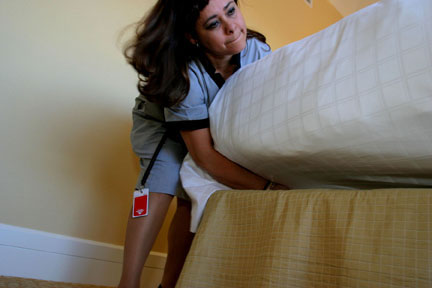
Dinorah Galdamez, a housekeeper at the Beverly Hilton Hotel, one of the most luxurious in the US. (Photo: David Bacon)
The 1930s and '40s were high points in the power of industrial and manual laborers. By that time, trucks had replaced the horse-drawn wagons that employed the area's first Teamsters. Assembly workers labored in huge factories, churning out automobiles and electrical equipment; construction workers built the bridges that span the bay and thousands of sailors and other marine workers sailed out on ships that packed the wharves.

A nurse and patient at Sequoia Hospital in Redwood City. (Photo: David Bacon)
The unions of the '30s ended the worst conditions that prevailed in the previous 70 years – ten-hour days and six-day weeks, job conditions that could sicken and kill, wages that could barely feed a family and constant fear of getting unfairly fired. The changes won by the unions of the '30s and '40s created an economic base for many working families to buy homes and send their children to college. The state responded by creating a system of universities and community colleges and, by the end of World War II, promised that any working-class kid who graduated high school would find a place in one of them. The nation's first employer-paid medical plan began in the Richmond shipyards.
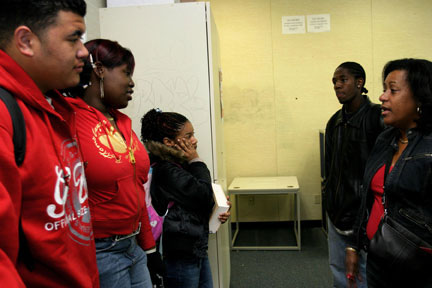
Vicki Stoneham teaches English at the Leadership Academy, a small public school in east Oakland. (Photo: David Bacon)
Belonging to a union gave workers from diverse backgrounds a common shared culture, with its own labor songs and activities built around the hall, from sports and fishing, to dancing, eating and other social activities.
Still, in the '30s and '40s, the Bay Area's workforce was rigidly divided by race and sex. A “color line” prevented African-Americans from getting skilled jobs in construction, industry and public services like fire and police. Women could work in some jobs, but were kept out of the best-paying ones. The general strike made one of the first cracks in that wall when striking longshoremen promised that, if African-Americans supported the effort, they'd force shipping companies to abandon the color line on the docks.
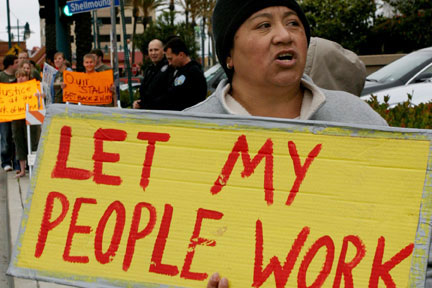
Workers from the Woodfin Suites Hotel protest the firing of immigrants in Emeryville, California. (Photo: David Bacon)
The promise was kept, and today people of color are a majority of the bay's dockworkers. Meanwhile, wartime work in the shipyards drew many African-Americans from homes in the south to new communities in California. Black families living in West Oakland and San Francisco's Fillmore and Western Addition neighborhoods shared a vibrant cultural life, with its clubs incubating jazz and bebop, while the promise of employment gave a new generation a sense of security.
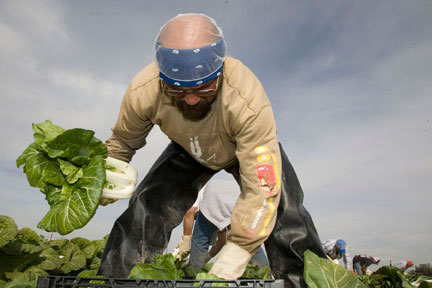
A crew of farm workers harvests bok choy for Vessey Farms in the Imperial Valley. (Photo: David Bacon)
But it wasn't until the civil rights movement of the 1960s that the color line came down in most areas, as a result of affirmative action decrees affecting jobs from building sites to fire houses. Demonstrations and active protest won women many gains as well. The reality today, however, is still that most women and workers of color earn less and are unemployed more than the workforce in general. Equality remains very much a work in progress.
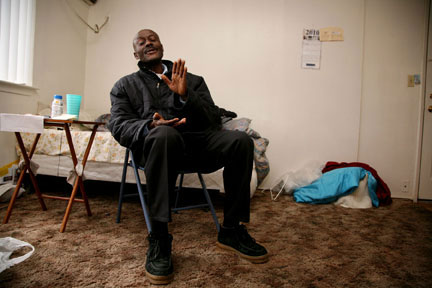
Peter Noah, a Nigerian immigrant, drives a taxi in Stockton. (Photo: David Bacon)
Immigration, too, transformed jobs and industries. European immigrants and their descendents made up the workforce in the best jobs in the Bay Area's budding economy of the late 1800s, in construction, transport and industry. Meanwhile, immigrants from China, Japan, Mexico and the Philippines drained the San Joaquin delta, developed the agriculture that became the base of the state's economy, laid the railroad tracks, served the meals and washed the clothes.
Immigration status caused few problems for those from Europe, but workers from Asia and Latin America faced continuing raids and deportations, especially when unemployment rose. While today these immigrants make up a growing section of the workforce in many areas, inequality based on immigration status, with rising raids and deportations, remain as well.
With the cold war of the 1950s and '60s, however, many things changed for Bay Area workers. Among those changes was an increasing question about the adequacy of the workers' compensation system. One case that highlighted the doubts was that of Marcos Vela.
Vela began working in the Johns-Manville asbestos factory in Pittsburg, California, in 1935. In 1959, the company began medical examinations to detect lung disease. A company doctor did a chest x-ray and found indications of asbestosis. But no one told Vela. In 1962, the same thing happened and again in 1965. In 1968, Vela's x-ray showed a “ground glass” appearance. But the company again told him he was fine, even though he'd begun to cough and couldn't catch his breath. Later that year, he was hospitalized and never went back to the plant.
Vela's case became a symbol of the failure of the existing system of occupational safety and health and helped win passage of the Occupational Safety and Health Act, signed by President Nixon. But Vela's case and that of other asbestosis victims also showed the limitations of the workers' compensation system. Christopher Boggs voices the common assertion that employers will clean up dangerous workplaces in order to avoid higher compensation premiums. “Human capital (the value of the employee) became a driving force behind the push for a system of protection,” he says, adding that, “recognition of the value of employees and other events between 1900 and 1911 helped spur the movement towards a social system of workers' compensation.”
Yet, higher compensation insurance premium costs didn't dissuade Johns Manville from maintaining a carcinogenic workplace, or from lying to its workers. Vela and his coworkers had to win the right to sue Johns Manville to enforce its liability and to win adequate compensation.
The radical political culture that built the unions of the previous decade came under attack during the cold war. Suddenly, workers needed to prove their loyalty to sail on a ship or teach in a school, and those who failed the tests, or refused to buckle under to them, found themselves out of a job and blacklisted. Many unions became more conservative in response and lost much of the vibrant culture that made them a part of workers' lives. Others fought hard and kept their leaders from being deported, as was attempted with ILWU President Harry Bridges and cannery union leader Lucio Bernabe. They won court cases protecting political rights and kept pushing for better conditions for workers.
But changes in technology changed the workplace greatly in the following decades and affected the power of unions as well. On the docks, the union was as strong as ever, but the number of longshore workers fell to less than a tenth of what it was during the general strike, as huge container cranes replaced the old hook and cargo net. Similar technological changes affected factory workers. Beginning in the 1970s, large employers moved production overseas and most of the big factories of the Bay Area began to close. Wrenching dislocation and unemployment devastated working families, as the old industrial base shrank to a small fraction of what it had been. In cities like Oakland and Richmond, which had been healthy working class communities, neighborhoods, especially African-American ones, were devastated by the consequences – permanent unemployment, poverty and drug use.
New industries arose at the same time, although not in the former industrial centers, but in areas like the South Bay. Burgeoning semiconductor and computer plants created job opportunities for a whole new wave of immigrants, mostly from the Asian Pacific rim. San Francisco and the East Bay experienced an explosion of service industry jobs – clerical workers in the new glass and steel office towers, hospital workers in the health care industry and retail workers in the malls that took the place of the old downtown shopping districts.
But these new jobs were not the same as the ones they replaced. The wages were generally lower, benefits fewer, employment much more temporary, and overwhelmingly, the employers were very hostile to unions. Beginning in the 1980s, therefore, the labor movement had to almost begin again from scratch, helping a new generation of workers to understand the advantages of being organized, which the general strike had made so clear to a generation before.
The development of high-tech industry also posed new challenges to efforts to protect workers' safety and health. Although the industry had a clean image, with no smokestacks belching visible pollution, the use of highly toxic solvents and other chemicals led to large waves of injured and poisoned workers. Often workers charged that the synergistic effects of exposure to many chemicals at once made them so sensitive that they could not even walk down the detergent aisle in a supermarket without painful reactions. Studies, even those by industry, documented a large increase in birth defects among workers in semiconductor plants.
The system of workers' compensation was often inadequate in analyzing these dangers and assuring workers of adequate compensation and treatment. Some affected workers organized a Disabled Workers United group to press for banning some chemicals and liability by the industry for causing the injuries. They viewed the workers' compensation system as overly favorable toward employers because it was hard to collect benefits for chemical exposure and it insulated employers from liability.
At the same time, laws passed under worker pressure, designed to encourage union organizing and protect public benefits like unemployment insurance and Social Security, came under attack from a wave of conservative administrations in Sacramento and Washington. Overtime pay, won through generations of strikes and protest, was stripped from six million workers nationally. As a result, while Bay Area unions included over a third of all workers in the 1950s, today they represent less than half that.
As unions struggled with this new environment, however, many workers did win new rights. The farmworkers movement, beginning in the 1960s, established the right of the state's poorest workers to form unions and achieve a decent standard of living. The union ended abuses like the infamous short-handled hoe, exposure to dangerous pesticides and the lack of bathrooms and drinking water in the fields. During the period of its greatest strength in the 1970s and early 1980s, the wage of a union farm worker was at least double the minimum wage, the highest level it has ever achieved.
The movement of rural workers was strongly supported by urban workers through the boycotts of struck fruits and vegetables. In the rural areas of California, Chicanos, Mexicans and Filipinos were able to end discrimination in schools and public services. The United Farm Workers, in turn, helped revitalize the fighting spirit of other unions and help them relearn the organizing tactics of a social movement.
Public workers, denied the right to organize and strike through the '30s and '40s, became some of the most active and numerous members of the labor movement by the 1980s. When teachers and nurses began forming unions in the '50s, they had to quit their jobs in protest in order to force public agencies to bargain. Today, legislation sets salary minimums in the classroom and protects the right to organize, while in hospitals, workers have won new laws establishing minimum staffing levels, protecting both jobs and patients.
That has made public worker unions a target for the political right, which seeks to reduce union strength even further by attacking the area where the labor movement now is strongest. The most severe economic crisis since the Depression has become the pretext for slashing education, public services and employment, while taxes paid by corporations and the wealthy continue to decline.
The growing costs of the workers' compensation insurance system became the subject of intense debate in the late 1990s and early 2000s and competing “reform” bills were put forward by Democrats and Republicans. During the years when unions held more power in Sacramento, they proposed reforms to try to hold down costs while protecting the right of workers to adequate compensation. When unions lost power, reforms passed that disqualified thousands of workers from benefits. The continued survival of the workers' compensation system as one that can provide adequate benefits to injured and sick workers is more clearly than ever tied to the size and strength of the labor movement.
Workers of a century ago would find the Bay Area a very different place. New industries have replaced old ones. Unions are more legally accepted, but have to fight just as hard. Worker protections and benefits have been legally recognized, but are being attacked. Race and sex discrimination is still a fact of life, but the fight to end it has scored important victories.
And that's what the veterans of the general strike would recognize most clearly. The world needs the labor of today's workers as much as it needed that of workers in an earlier era. And the effort by the Bay Area's working people to win power, equality and better lives for their families is still going on, as hot and hard as ever. Their answer to those problems – to get organized in strong and democratic unions – is the same one working families seek today.
This article (and photographs) are not to be reproduced without specific permission of the author.
Matching Opportunity Extended: Please support Truthout today!
Our end-of-year fundraiser is over, but our donation matching opportunity has been extended! Today, all donations to Truthout will be matched dollar for dollar. Your one-time gift today will be matched immediately. As well, your monthly donation will be matched for the whole first year, doubling your impact.
This matching gift comes at a critical time. Trump has made it no secret that he is planning a demolition-style attack on both specific communities and democracy as a whole, beginning on his first day in office.
Help us prepare for Trump’s Day One, and have your donation matched today!
